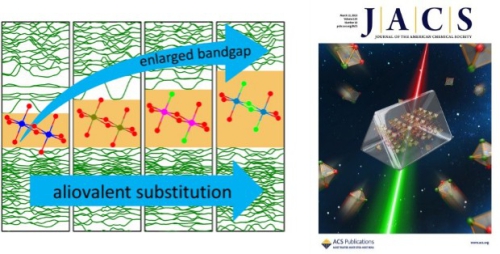
Mid-infrared (IR) coherent sources and Mid-IR nonlinear optical (NLO) crystals are widely applied in modern optoelectronics, including quantum information, optical computation, remote communications, biologic imaging, and so on.
Generally, high anti-laser damage threshold (LDT) and large nonlinear coefficients are two important but contradictory parameters for mid-IR NLO crystals. As a result, it is quite difficult to obtain excellent balance between them.
Over time, metal selenite family contains a rich source of mid-IR NLO materials owing to stereo-chemically active (SeO3)2- lone pairs groups, which exhibits strong second harmonic generation (SHG) response. However, their bandgaps are relatively small, it is in urgent demand to develop new metal selenite NLO crystals with enlarged bandgap and strengthened laser damage threshold.
Recently, Prof. LIN Zheshuai's group from Technical Institute of Physics and Chemistry (TIPC), Chinese Academy of Sciences, has proposed a general band engineering strategy to design new NLO metal selenite.
Based on massive structural screening and high throughput first principles calculations, they constructed a comprehensive database for NLO materials and study the deep structural-property relationship in them efficiently.
They put forward an effective method to enlarge NLO crystal bandgap and improve their LDT by removal of transition metals and introduction of fluorine atoms.
More impressively, guided by this strategy, they successfully synthesized a new NLO selenite Pb2GaF2(SeO3)2Cl, which exhibits a band gap among the widest value known, as well as strong SHG effect.
It also has a relatively high LDT value, which is near four times higher than that of isostructural compound.
On basis of theoretical calculations and experimental demonstration, Pb2GaF2(SeO3)2Cl crystal achieve good balanced criteria between high LDT and strong nonlinear effect, thereby leading to promising applications in future high-power mid-IR laser systems.
Furthermore, this work is also significant for structural design and property optimization in other optoelectronic functional materials.
The study entitled "Pb2GaF2(SeO3)2Cl: Band engineering strategy by aliovalent substitution for enlarging bandgap while keeping strong second harmonic generation response" has been recently published in Journal of the American Chemical Society as the cover of current issue.
This work was supported by the National Natural Science Foundation of China, Fujian Institute of Innovation (CAS) and Youth Innovation Promotion Association (CAS).

Schematic illustration of structural evolution and bandgap modulation by aliovalent substitution strategy (Image by TIPC)

86-10-68597521 (day)
86-10-68597289 (night)

86-10-68511095 (day)
86-10-68512458 (night)

cas_en@cas.cn

52 Sanlihe Rd., Xicheng District,
Beijing, China (100864)

